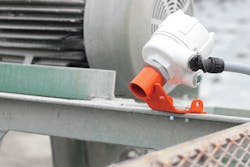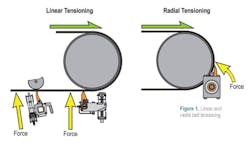How to optimize conveyor belt cleaning systems to maximize performance and service life
Controlling fugitive material in the form of dust and spillage has been recognized as a key factor in maximizing conveyor efficiency and safety. One way that operators minimize fugitive material is by using belt cleaners to remove carryback before it can escape from the system.
Most designs of conveyor belt cleaning technologies available today are blade-type units using a urethane or metal-tipped scraper mounted on the head pulley to remove material from the belt’s surface. These devices typically require a tensioner to hold the cleaning edge against the belt. Because the blade directly contacts the belt, it is subject to abrasive wear and must be regularly adjusted and periodically replaced to maintain effective cleaning performance.
Installing a blade that is wider than the material load can cause the center section of the blade to wear faster than the edges because there is more abrasive cargo in the middle. This results in an increase in carryback (see Image 1).
Tensioning
There is a popular misconception that the harder the cleaner is pressing against the belt, the better it will clean. However, too much pressure can force the tip away from the belt and leave a small gap, leading to hydroplaning. In addition, material wedged between the blade tip and belt can prematurely wear both the blade and belt.
As the urethane wears, the blade’s surface area increases, causing a reduction in blade-to-belt pressure and making it less efficient. Therefore, most mechanically tensioned systems require periodic adjustment (retensioning) to deliver the consistent pressure needed for effective carryback removal.
Linear-tensioned cleaners are pushed up (in a line) against the belt, and radially tensioned cleaners are installed with a mainframe as an axis and rotated into position. In addition, some hybrid systems incorporate vertical tensioning with a radial relief mechanism (see Figure 1).
Linear-adjusted cleaners generally require access to both sides to provide balanced pressure. Radialadjusted cleaners have several practical advantages. They are easier to install and rotate away from the belt to absorb the shock of belt motion and splice passage. When designed with a specially engineered curved blade, known as CARP (constant angle radial pressure), the contact angle and surface area are minimized as the blade wears, maintaining effectiveness throughout the cleaner’s service life.
Air tensioning
Pneumatic tensioners have some advantages versus mechanical tensioners. Mechanical tensioner designs require periodic maintenance as the cleaning blade wears down. Air tensioners maintain a consistent force on the blade, resulting in a constant cleaning pressure.
One automated pneumatic tensioning system is equipped with sensors to confirm that the belt is loaded and running. The system automatically backs the blade away during stoppages or when the conveyor is running empty, minimizing unnecessary wear to both the belt and cleaner. Automatically tensioning cleaners also reduce labor hours, allowing personnel to focus on other duties (see image at top).
Installation
Improper installation will have an adverse effect on how well the cleaner works, reducing both blade life and cleaning efficiency. Most performance problems with belt cleaner systems are due to improper installation, lack of maintenance or both.
Considerations affecting the installation position of a belt cleaner include:
- Cleaner design
- Tensioner and mounting requirements
- Bolting or welding the cleaner in place
- Installation on chute wall or hung from stringer
- Position of cleaner to avoid conveyor structural beams, bearings and drives
- Support for the cleaner
- Access for maintenance
Inspection and maintenance
Cleaning and service is critical, since many cleaners will eventually fail due to lack of informed maintenance and access for inspection. After startup, it may be impossible to correct for access and location problems. Nobody wants to lay on a pile of grease or spillage to try to get a peek at a cleaner buried in an inaccessible location, but this is often the case when accessibility is missing from the original design. Properly placing work platforms that allow mounting cleaners in a preferred location and providing for ergonomic maintenance will greatly improve the chances that the cleaner will be inspected frequently.
Even the best-designed and most efficient mechanical belt-cleaning systems require periodic maintenance and/or adjustment; otherwise, performance will deteriorate over time. Elements that can be incorporated into a conveyor belt cleaning system to improve maintenance procedures include:
- Adequate service access with ample clearances
- Access windows with easy-to-operate doors installed on both sides of the pulley, in line with the axis of the belt cleaners
- Cleaning elements that slide out for service, without mainframe removal
- Components including blades and mainframe that resist corrosion and abuse
- Components that allow quick adjustment and service with simple hand tools
- Automated load sensing and blade tensioning
In one survey of factory maintenance technicians, respondents estimated that only about 20 percent of all conveyors have the proper cleaning systems, and of those, just 20 to 25 percent are well maintained, reinforcing the benefits of automated tensioning. Some equipment manufacturers offer factory-direct service, reducing the workload on personnel and improving cleaning performance.
Factory-trained and certified specialty contractors can help ensure that belt cleaner maintenance is done properly and on an appropriate schedule. Further, experienced service technicians often notice other developing system or component problems that can be minimized if they are addressed before a catastrophic failure occurs, helping conveyor operators avoid potential equipment damage and expensive unplanned downtime.
By setting the cleaning goal necessary for each individual operation and purchasing a system adequate for those conditions as laid out in the Conveyor Equipment Manufacturers Association (CEMA) standards, it is possible to achieve carryback control and obtain long life from belt cleaners. The bottom line is that properly installed and adjusted belt cleaners help minimize carryback and spillage, reducing the risk of injuries and better managing overall operating costs.
Alan Highton began his career as a qualified millwright, after receiving his N6 National Certificate in mechanical engineering in South Africa. Highton joined Martin Engineering in 1996 as a service technician and was promoted to a sales position in 1999. He was named the RSA sales manager in 2006 and in 2012 was promoted to North American sales manager. He currently serves as the North American sales manager for Martin Engineering’s Wear Components division.
R. Todd Swinderman is a professional engineer with a Bachelor of Science from the University of Illinois. He joined Martin Engineering in 1979 as an engineer in conveyor products. He has served as vice president and general manager, president and CEO, as well as chief technology officer and technical director. He holds more than 140 active patents in 12 countries and has been instrumental in developing consistent standards to improve the safety and productivity of conveyor systems and components. He retired from Martin Engineering after more than 30 years to establish his own engineering firm, and currently shares his expertise with Martin as an independent consultant.


